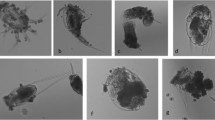Abstract
Infection of copepods by parasitic dinoflagellates has been known for many years, but the ecological consequences of this parasitism have been largely neglected. We estimated mortality rates in the copepodParacalanus indicus Wolfenden due to parasitism by the dinoflagellateAtelodinium sp. by applying laboratory mortality rates to a field population of infected copepods in Port Phillip Bay, Australia, sampled in 1982–1985. Adult female copepods were most often infected, with an incidence of 0 to 28.5% (median 6.2%). Stage V female copepodites were less often infected, and males were never infected. The median mortality rate in females was about 7% d−1, or about one-third of total mortality, and the maximum was 41% d−1. The frequent occurrence of dinoflagellate parasitoids in some species of copepod implies an important, species-specific mechanism for the regulation of populations.
Similar content being viewed by others
Literature cited
Brambilla, D. J. (1983). Microsporidiosis in aDaphnia pulex population. Hydrobiologia 99: 175–188
Burns, C. W. (1985). Fungal parasitism in a copepod population: the effects ofAphanomyces on the population dynamics ofBoeckella dilatata Sars. J. Plankton Res. 7: 201–205
Burns, C. W. (1989). Parasitic regulation in a population ofBoeckella hamata (Copepoda: Calanoida). Freshwat. Biol. 21: 421–426
Cachon, J., Cachon, M. (1987). Parasitic dinoflagellates. Taylor, F. J. R. (ed.) The biology of dinoflagellates, Blackwell, Oxford, p. 571–610
Chatton, E. (1910). Sur l'existence de dinoflagellés parasites coelomiques. LesSyndinium chez les copépodes parasites. C.r. hebd. Séanc. Acad Sci., Paris 102: 654–656
Chatton, E. (1920). Les péridiniens parasites; morphologie, reproduction, éthologie. Archs Zool. exp. gén. 59: 1–475
Checkley, D. M., Jr. (1980). Food limitation of egg production by a marine, plantonic copepod in the sea off Southern California. Limnol. Oceanogr. 25: 991–998
Coats, D. W., Heisler, J. J. (1989). Spatial and temporal occurrence of the parasitic dinoflagellateDuboscquella cachoni and its tintinnine hostEutintinnus pectinus in Chesapeake Bay. Mar. Biol. 101: 401–409
Corkett, C. J., McLaren, I. A. (1978). The biology ofPseudocalanus. Adv. mar. Biol. 15: 1–231
Fancett, M. S., Kimmerer, W. J. (1985). Vertical migration of the demersal copepodPseudodiaptomus as a means of predator avoidance. J. exp. mar. Biol. Ecol. 88: 31–43
Harding, G. C. H. (1973). Decomposition of marine copepods. Limnol. Oceanogr. 18: 670–673
Ho, J.-S., Perkins, P. S. (1985). Symbionts of marine copepoda: an overview. Bull. mar. Sci. 37: 586–598
Ianora, A., di Carlo, B. S., Mazzocchi, M. G., Mascellaro, P. (1990). Histomorphological changes in the reproductive condition of parasitized marine planktonic copepods. J. Plankton Res. 12: 249–258
Ianora, A., Mazzocchi, M. G., di Carlo, B. S. (1987). Impact of parasitism and intersexuality on Mediterranean populations ofParacalanus parvus (Copepoda: Calanoida). Dis. aquat. Organisms 3: 29–36
Johnson, P. T. (1986). Parasites of benthic amphipods: dinoflagellates (Dubosquodinida: Syndinidae). Fish. Bull. U.S. 84: 605–614
Kimmerer, W. J. (1987). The theory of secondary production calculations for continuously reproducing populations. Limnol. Oceanogr. 32: 1–13
Kimmerer, W. J., McKinnon, A. D. (1985). A comparative study of the zooplankton in two adjacent embayments, Port Phillip and Westernport Bay, Australia. Estuar., cstl Shelf Sci. 21: 145–159
Kimmerer, W. J., McKinnon, A. D. (1989). Zooplankton in a marine bay. III. Evidence for influence of vertebrate predation on distributions of two common copepods. Mar. Ecol. Prog. Ser. 53: 21–35
Landry, M. R. (1983). The development of marine calanoid copepods with comment on the isochronal rule. Limnol. Oceanogr. 28: 614–624
McLaren, I. A. (1978). Generation lengths of some temperate marine copepods: estimation, prediction, and implications. J. Fish. Res. Bd Can. 35: 1330–1342
Ohman, M. D. (1986). Predator-limited population growth of the copepodPseudocalanus sp. J. Plankton Res. 8: 673–713
Redfield, G. W., Vincent, W. F. (1979). Stages of infection and ecological effects of a fungal epidemic on the eggs of a limnetic copepod. Freshwat. Biol. 9: 503–510
Robertson, A. I., Howard, R. K. (1978). Diel trophic interactions between vertically-migrating zooplankton and their fish predators in an eelgrass community. Mar. Biol. 48: 207–213
Sewell, R. B. S. (1951). The epibionts and parasites of the planktonic Copepoda of the Arabian Sea. Scient. Rep. John Murray Exped. 9: 255–394
Sheldon, R. W., Sutcliffe, W. H., Jr., Paranjape, M. A. (1977). Structure of pelagic food chain and relationship between plankton and fish production. J. Fish. Res. Bd. Can. 34: 2344–2353
Soyer, M.-O. (1974). Etude ultrastructural deSyndinium sp. Chatton. Parasite coelomique de copépodes pelagiques. Vie Milieu (sér. A) 25: 191–212
Wheeler, E. H. (1967). Copepod detritus in the deep sea. Limnol. Oceanogr. 12: 697–701
Author information
Authors and Affiliations
Additional information
Communicated by M. G. Hadfield, Honolulu
Rights and permissions
About this article
Cite this article
Kimmerer, W.J., McKinnon, A.D. High mortality in a copepod population caused by a parasitic dinoflagellate. Mar. Biol. 107, 449–452 (1990). https://doi.org/10.1007/BF01313428
Accepted:
Issue Date:
DOI: https://doi.org/10.1007/BF01313428




